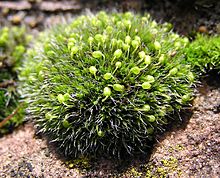Grimmia
| Grimmia | |
|---|---|
 |
|
| Grimmia pulvinata | |
| Scientific classification | |
| Kingdom: | Plantae |
| Division: | Bryophyta |
| Class: | Bryopsida |
| Subclass: | Bryidae |
| Order: | Grimmiales |
| Family: | Grimmiaceae |
| Genus: |
Grimmia Hedw. |
Grimmia is a genus of mosses (Bryophyta), originally named by Jakob Friedrich Ehrhart in honour of Johann Friedrich Carl Grimm, a physician and botanist from Gotha, Germany.
Although predominantly occurring in the moderate zones, representatives of the cosmopolitan genus Grimmia may be found in all parts of the world, from Alaska to the most southern point of Chile, and from Siberia to South Africa, though in tropic regions, e.g. Hawaii and Indonesia, Grimmia species only occur high up in the mountains.
Grimmia is a notoriously difficult genus in terms of identification, and in the majority of herbaria a considerable number of species was found misidentified. The American bryologist Geneva Sayre (1911–1992), who worked for many years on a monograph of the North American Grimmias, indicated in an original way these difficulties, as she said: "it contains an ambigua, a varia, a decipiens, a controversa, a revisa and at least two anomalas".
In the Index Muscorum, the genus Grimmia is represented with 800 names of published species. As since Loeske (1930), no revision of the European species had been carried out.
The Dutch bryologist H. C. Greven started in 1990 with Grimmia fieldwork and a revision of the Grimmia collections from important European herbaria. The results were published in "Grimmia Hedw. (Grimmiaceae, Musci) in Europe".
...
Wikipedia
